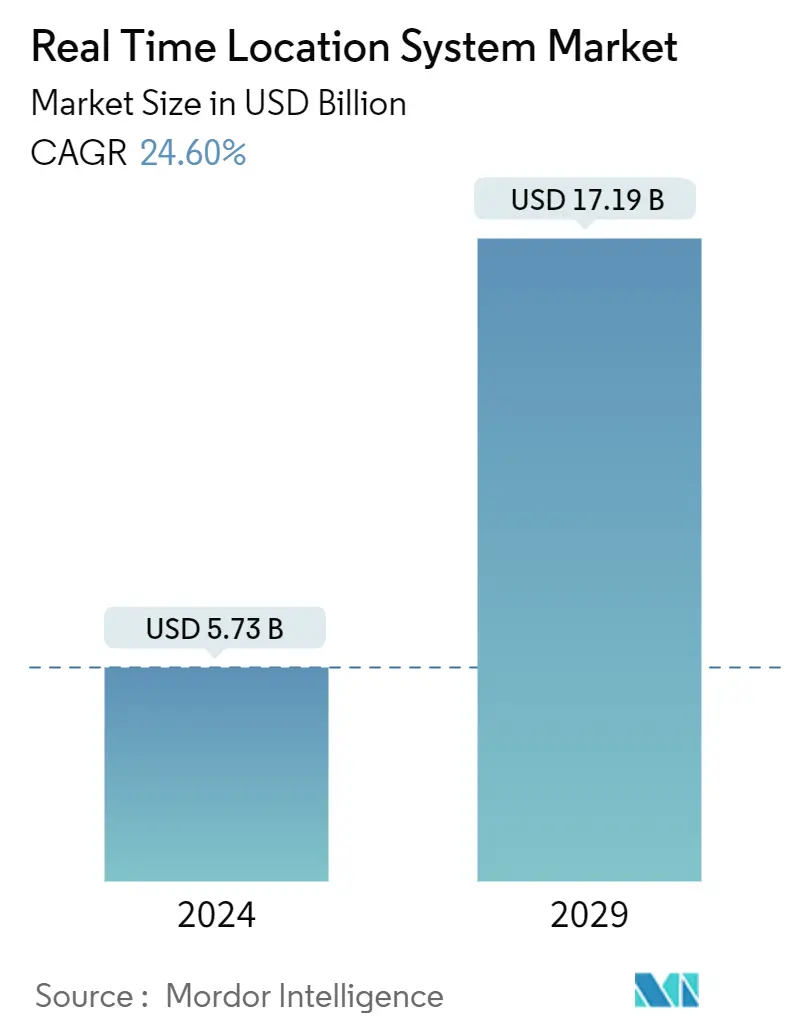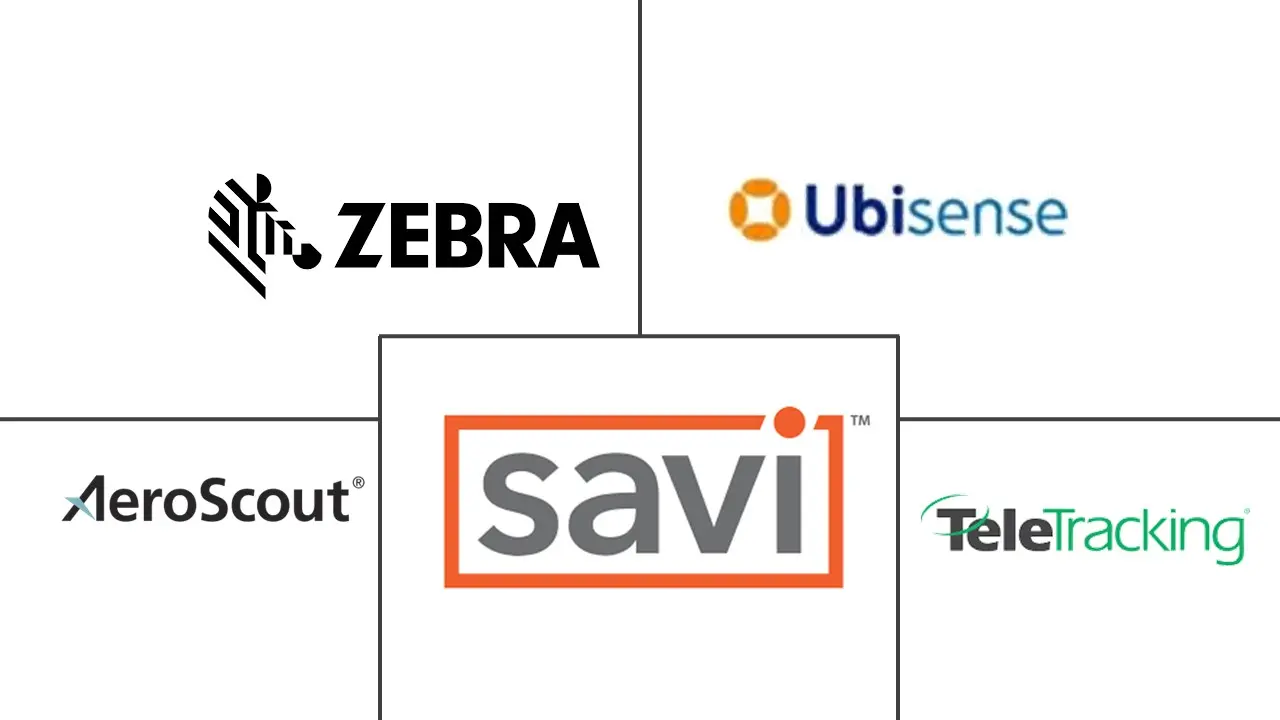Market Size of Real Time Location System Industry

| Study Period | 2019 - 2029 |
| Market Size (2024) | USD 5.73 Billion |
| Market Size (2029) | USD 17.19 Billion |
| CAGR (2024 - 2029) | 24.60 % |
| Fastest Growing Market | Asia Pacific |
| Largest Market | Asia Pacific |
| Market Concentration | Medium |
Major Players
*Disclaimer: Major Players sorted in no particular order |
Real Time Location System Market Analysis
The Real Time Location System Market size is estimated at USD 5.73 billion in 2024, and is expected to reach USD 17.19 billion by 2029, growing at a CAGR of 24.60% during the forecast period (2024-2029).
- Implementing real-time tracking in corporate processes boosts accuracy and productivity, enhances employee safety, streamlines logistical and supply chain operations, and optimizes overall processes. Key drivers fueling the growth of the RTLS market include rising demand for asset tracking, widespread smartphone usage, growing adoption of business analytics solutions, and heightened awareness of the benefits of real-time location systems.
- Real-time location systems (RTLS) are pivotal in electric vehicles (EVs) for enhancing navigation, managing fleets, and boosting energy efficiency. Leveraging technologies such as GPS, GNSS, and IoT connectivity, these systems ensure accurate location tracking and associated features. For instance, according to the IEA (International Energy Agency), 2023 saw plug-in electric light vehicle (PEV) sales of around 13.7 million units. Such a huge number of electric vehicles would propel the market growth.
- The integration of real-time location systems (RTLS) has transformed the logistics industry, revolutionizing the management of goods, vehicles, and processes. RTLS empowers stakeholders to monitor shipments and inventory in real-time, providing end-to-end visibility. This capability minimizes the risk of misplaced goods and bolsters accountability. For instance, according to the Ministry of Ports India, in fiscal year 2023, India witnessed a total container volume exceeding 170 million metric tons, marking a notable uptick from the previous year. Such a huge number of containers would propel the public and private agencies to deploy RTLS for smooth operations.
- Real-Time Location Systems (RTLS) provide substantial advantages in areas such as asset tracking, logistics, and personnel monitoring. However, they also bring forth significant privacy and security challenges. These challenges arise from the handling of sensitive location data. Monitoring individuals without their clear consent can result in ethical and legal breaches, particularly in workplaces or public venues. Holding onto location data for extended periods heightens the chances of misuse or breaches, potentially contravening privacy laws like GDPR or CCPA. Furthermore, if these systems are compromised, there's a risk of exposing both real-time and historical location data, jeopardizing user privacy and safety.
- Macroeconomic factors wield considerable influence over the adoption, development, and market dynamics of Real-Time Location Systems (RTLS). These systems hinge on a sophisticated blend of hardware, software, and network infrastructure, all of which are susceptible to macroeconomic fluctuations. Take inflation, for instance: It can drive up the costs of RTLS components. Consequently, this surge in component costs elevates the overall price of RTLS solutions. Such price hikes might deter SMEs from embracing these systems, perceiving them as capital-intensive investments.
- For instance, according to the International Monetary Fund (IMF), the inflation rate in 2023 was 6.78% and is expected to reach 3.37% by 2029. A decline in the inflation rate would change the dynamics of the market.
Real Time Location System Industry Segmentation
Real-time locating systems (RTLS) are used to automatically identify and track the location of objects or people in real-time, usually within a building or other contained area. The improved real-time tracking ability in diverse business processes boosts the real-time location systems market share. These systems provide increased productivity, accuracy, and operational excellence. Among the RTLS technologies, the demand for RFID tags has been increasing in the healthcare sector because RFID tags can be used in many forms, such as tracking surgical tools and patients and staff.
The real-time locating systems (RTLS) market is segmented by end-user vertical (healthcare, manufacturing, retail, transportation and logistics, government and defense, oil, and gas), component (hardware, software and services), and geography (North America, Europe, Asia-Pacific, Latin America, Middle East & Africa). The market sizes and forecasts are provided in terms of value (USD) for all the above segments.
| By End-user Vertical | ||||||||||
| ||||||||||
| ||||||||||
| ||||||||||
| ||||||||||
| ||||||||||
|
| By Component | |
| Hardware | |
| Software and Services |
| By Geography*** | |
| North America | |
| Europe | |
| Asia | |
| Australia and New Zealand | |
| Latin America | |
| Middle East and Africa |
Real Time Location System Market Size Summary
The real-time location system (RTLS) market is poised for significant growth, driven by its increasing adoption across various sectors, particularly healthcare. RTLS technology, which utilizes wireless systems to determine the current position of objects, is becoming essential for indoor tracking applications. This is especially true in the healthcare sector, where it aids in monitoring patient safety and operational efficiency. The integration of IoT and wearable devices further enhances productivity and user engagement, making RTLS a valuable tool for reducing workplace accidents and improving patient care. Despite the high initial setup and maintenance costs, the demand for RTLS is expected to rise as industries seek to streamline operations and mitigate risks.
The Asia-Pacific region is anticipated to experience the fastest growth in the RTLS market, fueled by the burgeoning healthcare industry and the adoption of Industry 4.0 and IoT in manufacturing. Countries like India and China are at the forefront of this expansion, with significant opportunities in sectors such as transportation, logistics, and defense. The market is characterized by fragmentation, with key players like Zebra Technologies, Ubisense Group, and TeleTracking Technologies actively pursuing mergers, acquisitions, and product innovations to capitalize on emerging opportunities. Recent developments, such as Sewio's introduction of Trackables and India's cargo tracking app, highlight the ongoing advancements and strategic initiatives shaping the market's future.
Real Time Location System Market Size - Table of Contents
-
1. MARKET INSIGHTS
-
1.1 Market Overview
-
1.2 Industry Attractiveness - Porter's Five Forces Analysis
-
1.2.1 Bargaining Power of Suppliers
-
1.2.2 Bargaining Power of Buyers/Consumers
-
1.2.3 Threat of New Entrants
-
1.2.4 Threat of Substitute Products
-
1.2.5 Intensity of Competitive Rivalry
-
-
1.3 Key Stakeholder Analysis
-
1.4 Assessment of COVID-19 Impact on the Market
-
-
2. MARKET SEGMENTATION
-
2.1 By End-user Vertical
-
2.1.1 Healthcare
-
2.1.1.1 Major Applications
-
2.1.1.2 Segmentation by Technology
-
2.1.1.2.1 Bluetooth
-
2.1.1.2.2 Wi-Fi
-
2.1.1.2.3 RFID
-
2.1.1.2.4 Ultra-wideband (UWB)
-
2.1.1.2.5 InfraRed (IR)
-
-
-
2.1.2 Manufacturing
-
2.1.2.1 Major Applications
-
2.1.2.2 Segmentation by Technology
-
2.1.2.2.1 Bluetooth
-
2.1.2.2.2 RFID
-
2.1.2.2.3 Wi-Fi
-
2.1.2.2.4 UWB
-
-
-
2.1.3 Retail
-
2.1.3.1 Major Applications
-
2.1.3.2 Segmentation by Technology
-
2.1.3.2.1 Wi-Fi
-
2.1.3.2.2 UWB
-
2.1.3.2.3 Bluetooth
-
-
-
2.1.4 Transportation and Logistics
-
2.1.4.1 Major Applications
-
2.1.4.2 Segmentation by Technology
-
2.1.4.2.1 RFID
-
2.1.4.2.2 UWB
-
2.1.4.2.3 Bluetooth
-
-
-
2.1.5 Government and Defense
-
2.1.5.1 Major Applications
-
2.1.5.2 Segmentation by Technology
-
2.1.5.2.1 RFID
-
2.1.5.2.2 UWB
-
-
-
2.1.6 Oil and Gas
-
2.1.6.1 Major Applications
-
2.1.6.2 Segmentation by Technology
-
2.1.6.2.1 RFID
-
2.1.6.2.2 UWB
-
-
-
-
2.2 By Component
-
2.2.1 Hardware
-
2.2.2 Software and Services
-
-
2.3 By Geography***
-
2.3.1 North America
-
2.3.2 Europe
-
2.3.3 Asia
-
2.3.4 Australia and New Zealand
-
2.3.5 Latin America
-
2.3.6 Middle East and Africa
-
-
Real Time Location System Market Size FAQs
How big is the Real Time Location System Market?
The Real Time Location System Market size is expected to reach USD 5.73 billion in 2024 and grow at a CAGR of 24.60% to reach USD 17.19 billion by 2029.
What is the current Real Time Location System Market size?
In 2024, the Real Time Location System Market size is expected to reach USD 5.73 billion.

